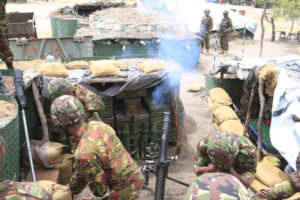
Kenya Defence Forces’ soldier ducks to safety after firing a grenade in Somalia, on February 11, 2017. They are fighting Al-Shabaab militants. Tactical withdrawal should happen when the Somalia army is well equipped. PHOTO | JEFF ANGOTE | NATION MEDIA GROUP
By FRED MUKINDA
Almost six years since Kenya Defence Forces (KDF) moved to Somalia, debate still rages on whether the combat mission is tenable.
General Thomas Waldhauser of the United States Marines, a key ally of Kenya’s involvement in Somalia, says that ultimately Kenya will withdraw from Somalia, but it is not yet time.
He recommends a tactical withdrawal. This should happen when the Somalia National Army is well equipped and big enough in terms of personnel to take on Al-Shabaab terrorist group on its own.
Amisom
Speaking at US Africa Command in Stuttgart, Germany, he said: “In Amisom, there has been discussion on departure and, at some point, it is going to be inevitable.
“After the London conference, one of the things that came out is that you can’t simply walk away, or fall out.
“There needs to be a type of transition. Troop-contributing countries can’t stay there forever.
“President Farmajo needs to make sure that the Somalia national army is ready for that.”
Amisom is the Africa Union Mission in Somalia and is supported by the United Nations.
Mr Mohamed Abdullahi “Farmajo” Mohamed is the President of the federal republic of Somalia.
The London conference, which General Waldhauser referred to, was attended by President Uhuru Kenyatta in May.
The conference by world leaders discussed accelerated progress on security sector reform, humanitarian crisis in Somalia and “international partnerships needed to keep Somalia on course for increased peace and prosperity by 2020”.
Somalia army
That is the year the Kenya Defence Forces are supposed to pull out of Somalia after the end of the Amisom mandate.
This is one of the challenges General Waldhauser, and by extension Kenya, is facing in Somalia.
He said: “Nobody expects Amisom to stay there forever. Somalia National Defence Forces are expected to pick the ball and make it as seamless as possible.
“President Farmajo said he has challenges. He is well aware and obviously he’s training and equipping the Somalia army.”
He went on: “At the London conference, he laid out the overall Somalia security architecture. It is a very good start.
“To the United States, we have people there to train, assist and accompany. We have a number of other states that are also part of the effort.
“One other big challenge is to pull together all the effort of all the countries involved in the training, because some train at the institutional level, and some at the tactical level.
“The challenge we have is to synchronise all the efforts to head in the same direction”
The issue of retaining Kenya Defence Forces has not escaped the country’s politics.
Fall back
President Uhuru Kenyatta, who is also the commander in chief of KDF, wants to retain boots on the ground but demands that other world leaders empower the mission by upgrading it to a fully-fledged United Nations Mission.
His key opponent and opposition chief, Mr Raila Odinga, wants the Kenyan troops to retreat to the border.
During the campaigns ahead of the August 8 election, the KDF incursion in Somalia was among the key issues.
During the presidential debate prior to the election, Mr Odinga laid bare what hitherto remained a State secret concerning the war in Somalia.
He said: “I was on the national security (council) when we took a decision to take our troops to Somalia… We called it Operation Linda Nchi.
“When we moved to Somalia, we got information from the military that pushing out Al-Shabaab from Somalia would not amount to much unless we liberated the port of Kismayu, which was their main source of supplies.”
Attacks
Mr Odinga was the Prime minister and Mr Kenyatta was one of his two deputies.
He went on: “We did apply for international support, the US declined and the EU (European Union) also declined.
“So we decided to use our own military, air force, navy and land army to liberate Kismayu. That caused a relief to Ugandan troops marooned in Mogadishu (Somaila’s capital).”
The former PM also said: “Thereafter, we should have retreated to our borders. But what happened was that our troops were rehatted and led part of Amisom troops inside Somalia.
“In the meantime, Al-Shabaab continued to penetrate our territory and carry out attacks in Mandera, Wajir, Lamu and so on.”
General Waldhauser said Kenya has done well both in Somalia and at the border.
“Kenya has a huge take on the border because it has been a challenge for quite some time.
“I would say US works closely with the Rangers and they are a very, very, good outfit. We have a lot of activity there on the Kenyan border,” he said.
The Rangers is a unit of the Kenya Army, which is trained by the US military almost to the level of Navy SEALS.
Source: The East African

Leave a Reply